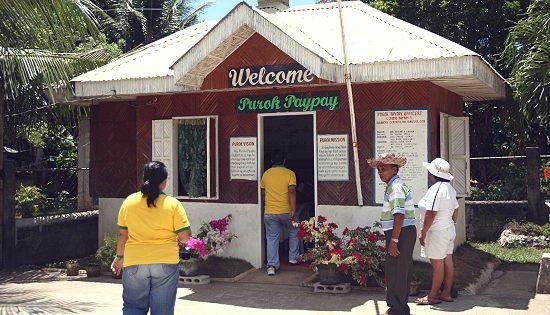|

Every
purok in the barangays of San Francisco, Camotes has a purok
center that serves as a meeting hall of the purok officers and
the residents, as well as a place where records of the purok's
services and activities are kept. |
Puroks drive town’s
success
By
CHRISLEY
ANN HINAYAS / Ramon Aboitiz Foundation Inc.
October 14, 2012
CEBU CITY –
Think big, start small.
This is what Vice Mayor
Alfredo Arquillano of San Francisco, Camotes Island, Cebu believes in
when he established the purok system in the town.
During the recent expanded
Green and Wholesome Environment that Nurtures (eGwen) Our Cebu Program
Partners’ Conference, he attributed the success and development of his
town on their focused efforts on grassroot level of governance – the
puroks.
A purok is the smallest unit
of governance composed of a number of households with an average of 20
to 50 or more number of members, depending on a particular
geographical location or cluster of houses. Given the mandate through
local ordinances enacted by barangay or municipal/city sanggunian, a
purok can perform government functions with the coordination and
supervision of the local officials.
“Puroks are the basis for
community-based governance and empowerment. If all people will
cooperate and move towards a common aim, each one of us can make a big
difference in our towns,” Arquillano said.
He recalled how one incident
had inspired him to revive the purok system in 2004.
“There was a group of black
birds locally known as galansiang that caused a big branch of a
pine tree to fall in front our hall. It was an incident that was
impossible if only one bird made it. I know it was a message from
above to take immediate actions,” he recalled.
After the incident, the
creation of a purok system came to life. It started with a few willing
puroks in the town proper where the municipality office is located.
Only when the first one started to work and showed results that others
followed.
“Dream for your community
but start with those who are willing to cooperate. The involvement of
the community in local governance enables us to be organized and draw
out plans for the municipality,” he said.
Arquillano noted that the
strengthening of puroks in the town enabled the people to be equipped
with understanding and discipline on proper waste management and
disaster preparedness.
“They are doing these things
because they are acknowledging ownership of their projects and they
feel proud. Now, we have cleaner and safer communities because people
are doing something with a common vision,” he shared.
The delivery of basic
services and implementation of programs and projects in the areas of
health, education, environment, social services, economic, and
disaster management of the Municipality of San Francisco are cascaded
down to the puroks.
He advised that the
municipality or city should have a ‘big picture’ on what they want to
achieve in their areas and what actions should be taken to realize
them.
“Don’t give dole-outs. The
community should earn it. Development is not just about money.
Community participation has a lot to offer than that,” he said,
pointing out that environment and socio-economic problems cannot be
solved by one person alone. It is the community who runs and manages
their own places.
“Never stop thinking of good
things to happen. We can make our plans possible if we help one
another. Think big, start small. That is the concept behind the purok
system,” he added.
Arquillano is glad that
other municipalities in the province of Cebu have adapted the purok
system in the barangays.
“Hopefully, local government
units (LGUs) in Cebu will learn from our experience and be able to
replicate our best practice. It is indeed that development starts from
the smallest unit of governance. It is the community that builds the
nation,” he disclosed.
At present, San Francisco,
Camotes has 15 barangays and 120 puroks.
San Francisco, Camotes
Island, Cebu, a recipient of the 2011 United Nations Sasakawa Award
for Disaster Risk Reduction, highlighted the establishment of purok
systems in their town as their best approach to mitigate the
destructive effects of natural calamities.
The town also ranked first
for three straight consecutive years in the eGWEN Our Cebu Program, a
joint development program of the Ramon Aboitiz Foundation Inc. (RAFI)
and the Cebu Provincial Government to make Cebu a liveable place.